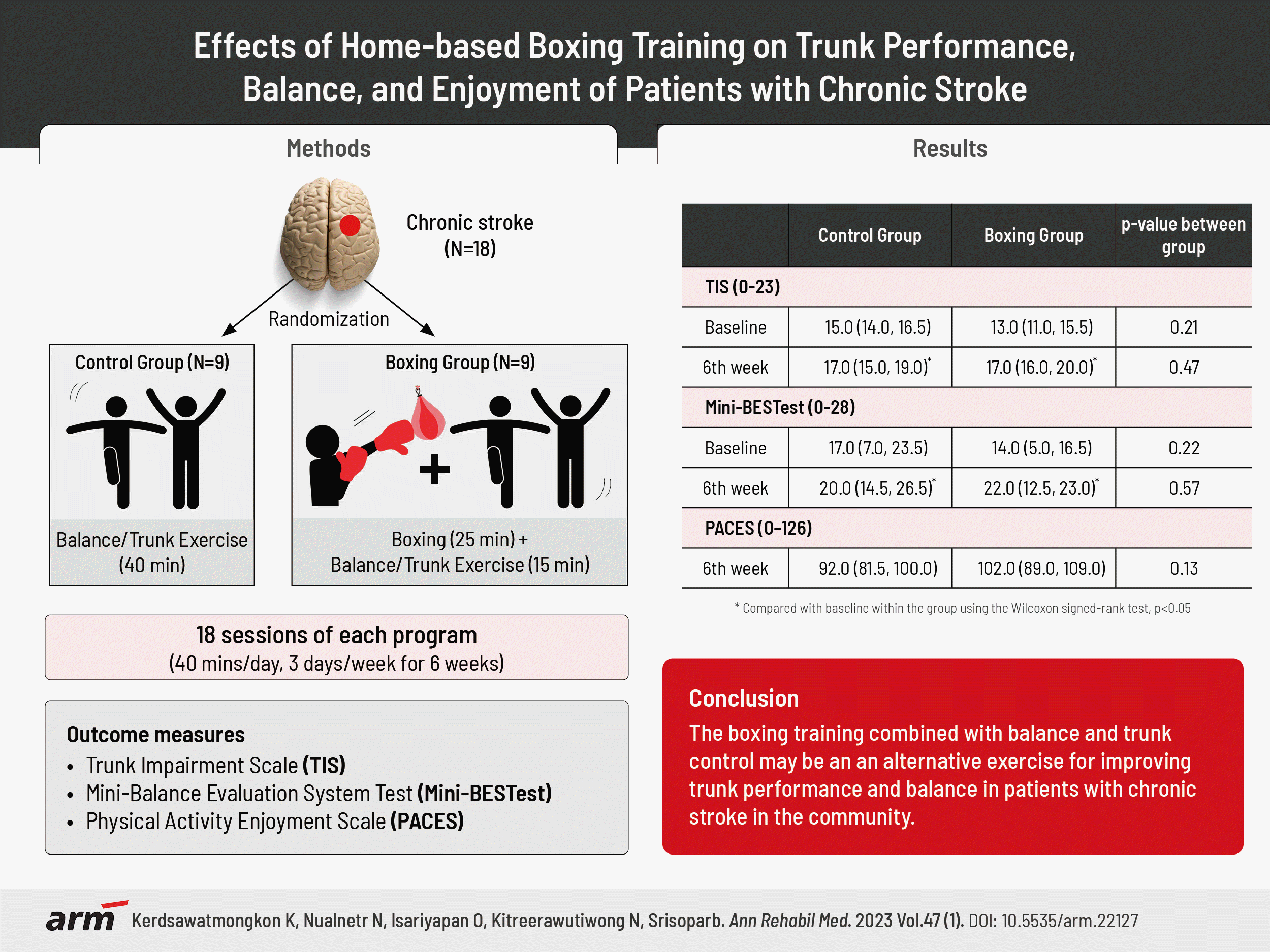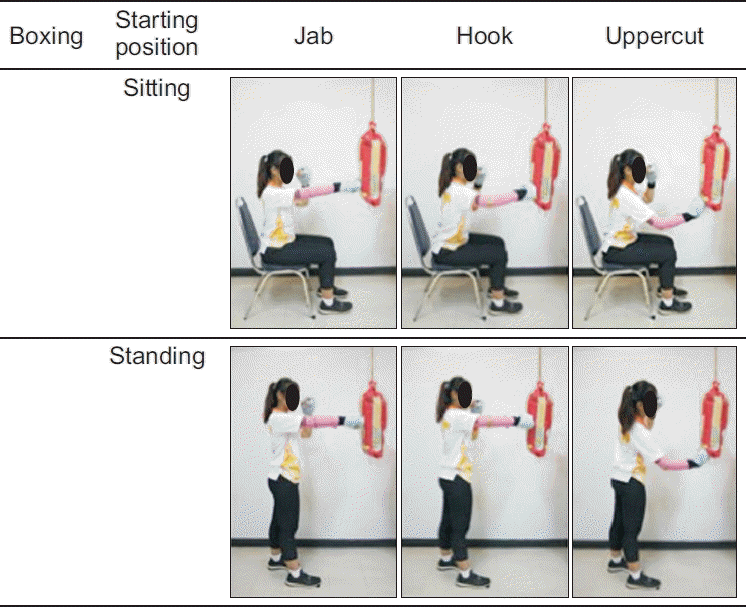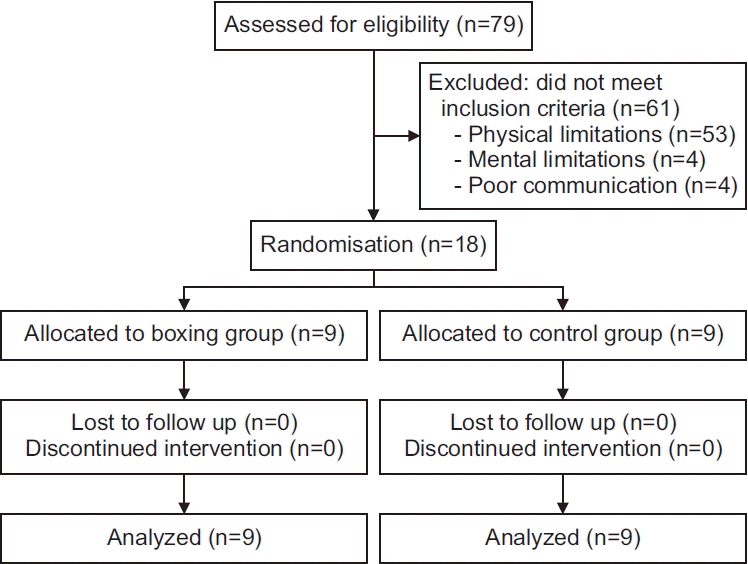1. Bohannon RW, Cassidy D, Walsh S. Trunk muscle strength is impaired multidirectionally after stroke. Clin Rehabil. 1995; 9:4–51.
2. Yoo J, Jeong J, Lee W. The effect of trunk stabilization exercise using an unstable surface on the abdominal muscle structure and balance of stroke patients. J Phys Ther Sci. 2014; 26:857–9.
3. Chen BL, Guo JB, Liu MS, Li X, Zou J, Chen X, et al. Effect of traditional Chinese exercise on gait and balance for stroke: a systematic review and meta-analysis. PLoS One. 2015; 10:e0135932.
4. Thayabaranathan T, Andrew NE, Immink MA, Hillier S, Stevens P, Stolwyk R, et al. Determining the potential benefits of yoga in chronic stroke care: a systematic review and meta-analysis. Top Stroke Rehabil. 2017; 24:279–87.
5. King LA, Horak FB. Delaying mobility disability in people with Parkinson disease using a sensorimotor agility exercise program. Phys Ther. 2009; 89:384–93.
6. Haruyama K, Kawakami M, Otsuka T. Effect of core stability training on trunk function, standing balance, and mobility in stroke patients. Neurorehabil Neural Repair. 2017; 31:240–9.
7. Jackson K, Edginton-Bigelow K, Bowsheir C, Weston M, Grant E. Feasibility and effects of a group kickboxing program for individuals with multiple sclerosis: a pilot report. J Bodyw Mov Ther. 2012; 16:7–13.
8. Jackson K, Edginton-Bigelow K, Cooper C, Merriman H. A group kickboxing program for balance, mobility, and quality of life in individuals with multiple sclerosis: a pilot study. J Neurol Phys Ther. 2012; 36:131–7.
9. Combs SA, Diehl MD, Chrzastowski C, Didrick N, McCoin B, Mox N, et al. Community-based group exercise for persons with Parkinson disease: a randomized controlled trial. NeuroRehabilitation. 2013; 32:117–24.
10. Combs SA, Diehl MD, Staples WH, Conn L, Davis K, Lewis N, et al. Boxing training for patients with Parkinson disease: a case series. Phys Ther. 2011; 91:132–42.
11. Park J, Gong J, Yim J. Effects of a sitting boxing program on upper limb function, balance, gait, and quality of life in stroke patients. NeuroRehabilitation. 2017; 40:77–86.
12. Jeon SH, Lee SM, Kim JH. Therapeutic effects of reaching with forward bending of trunk on postural stability, dynamic balance, and gait in individuals with chronic hemiparetic stroke. J Phys Ther Sci. 2015; 27:2447–51.
13. Verheyden G, Nieuwboer A, Mertin J, Preger R, Kiekens C, De Weerdt W. The Trunk Impairment Scale: a new tool to measure motor impairment of the trunk after stroke. Clin Rehabil. 2004; 18:326–34.
14. Verheyden G, Kersten P. Investigating the internal validity of the Trunk Impairment Scale (TIS) using Rasch analysis: the TIS 2.0. Disabil Rehabil. 2010; 32:2127–37.
15. Tsang CS, Liao LR, Chung RC, Pang MY. Psychometric properties of the Mini-Balance Evaluation Systems Test (Mini-BESTest) in community-dwelling individuals with chronic stroke. Phys Ther. 2013; 93:1102–15.
16. Powell LE, Myers AM. The Activities-specific Balance Confidence (ABC) Scale. J Gerontol A Biol Sci Med Sci. 1995; 50A:M28–34.
17. Murrock CJ, Bekhet A, Zauszniewski JA. Psychometric evaluation of the physical activity enjoyment scale in adults with functional limitations. Issues Ment Health Nurs. 2016; 37:164–71.
18. Oguz S, Demirbuken I, Kavlak B, Acar G, Yurdalan SU, Polat MG. The relationship between objective balance, perceived sense of balance, and fear of falling in stroke patients. Top Stroke Rehabil. 2017; 24:527–32.
19. Cole J. Proprioception: effect of neurological disease. In : Binder MD, Hirokawa N, Windhorst U, editors. Encyclopedia of neuroscience. Berlin, Heidelberg: Springer;2009. p. 3309–11.
20. Jung K, Kim Y, Chung Y, Hwang S. Weight-shift training improves trunk control, proprioception, and balance in patients with chronic hemiparetic stroke. Tohoku J Exp Med. 2014; 232:195–9.
21. Levin MF, Michaelsen SM, Cirstea CM, Roby-Brami A. Use of the trunk for reaching targets placed within and beyond the reach in adult hemiparesis. Exp Brain Res. 2002; 143:171–80.
22. Friedli WG, Cohen L, Hallett M, Stanhope S, Simon SR. Postural adjustments associated with rapid voluntary arm movements. II. Biomechanical analysis. J Neurol Neurosurg Psychiatry. 1988; 51:232–43.
23. Beauchamp MK, Niebuhr R, Roche P, Kirkwood R, Sibley KM. A prospective study to establish the minimal clinically important difference of the Mini-BESTest in individuals with stroke. Clin Rehabil. 2021; 35:1207–15.
24. Kim JS, Lee JH, Im JH, Lee MC. Syndromes of pontine base infarction. A clinical-radiological correlation study. Stroke. 1995; 26:950–5.
25. Datar S, Rabinstein AA. Cerebellar infarction. Neurol Clin. 2014; 32:979–91.
26. Azzollini V, Dalise S, Chisari C. How does stroke affect skeletal muscle? State of the art and rehabilitation perspective. Front Neurol. 2021; 12:797559.




 PDF
PDF Citation
Citation Print
Print






 XML Download
XML Download